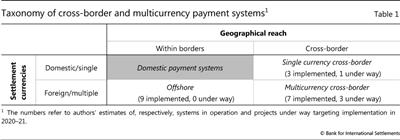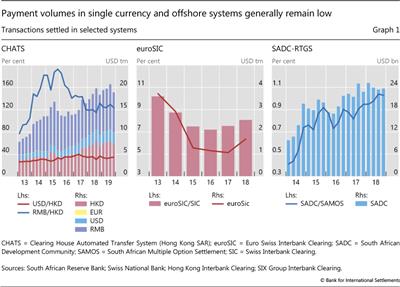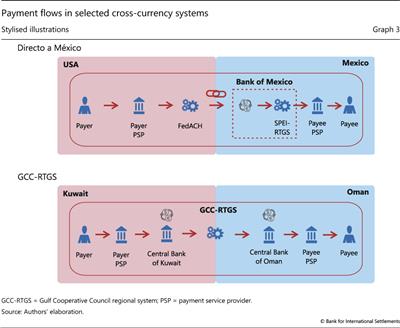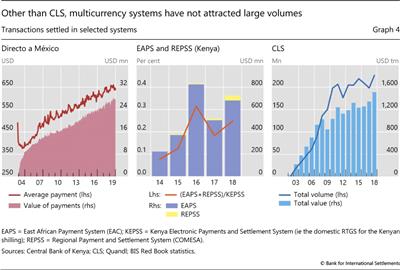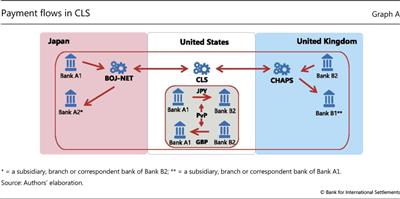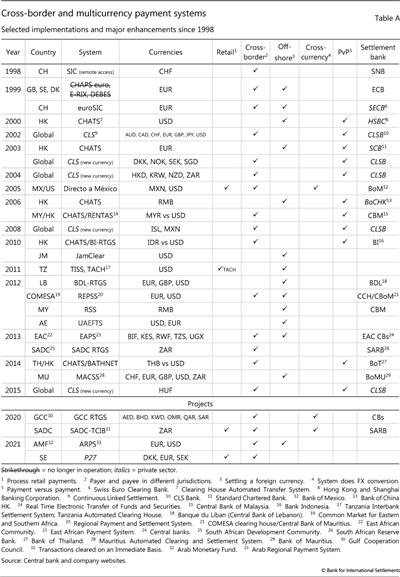Payments without borders
Cross-border and multicurrency payment systems have the potential to make cross-border payments faster, cheaper and more transparent. A simple taxonomy reviews the different designs and functionality of existing systems. Such systems remain rare, and most handle small volumes and values. However, a number of new projects will go live in the next few years.1
JEL classification: E42.
Cross-border payments are generally slower, more expensive and more opaque than domestic ones. They tend to flow through the so-called correspondent banking network, where chains of banks work to get funds from the payer to the payee.
There are several ways to potentially improve cross-border payments. One is to streamline processing along the chains of correspondent banks.2 Another is to replace the payment chains (or parts thereof) with dedicated cross-border and/or multicurrency (CBMC) payment systems.
This special feature focuses on the latter approach by looking at existing systems with a view to drawing lessons. While CBMC arrangements are not new, they are relatively rare. One reason is the complications in setting them up. On top of operational challenges, some complexities of domestic systems are amplified in a cross-border context. These include cross-border governance, conflict of laws issues, and adherence to multiple anti-money laundering (AML) and combating the financing of terrorism (CFT) regimes. Moreover, some issues are unique to cross-border or cross-currency systems such as foreign exchange (FX) conversion and liquidity management in foreign currencies. These are not always straightforward to solve. In addition, the volumes and values processed by existing systems are often very low (both in absolute terms and relative to domestic systems), suggesting that "build it and they will come" does not uniformly apply to CBMC systems.
Key takeaways
- Payments across borders and currencies can be made faster, cheaper and more transparent by linking domestic systems, allowing banks from abroad remote access or building dedicated systems.
- Cross-border and multicurrency payment systems are more complex to set up and operate than domestic systems.
- There are only a handful of successful examples at present, but new systems are being implemented or planned.
Statistical data: data behind all graphs
After a recent lull in new CBMC systems, things may be at a turning point. A number of new systems are in the pipeline and likely to go live in the next few years. Moreover, the type of CBMC systems is changing. Whereas past systems have primarily focused on wholesale payments, some of the newer projects aim at retail flows.
The feature starts by presenting a taxonomy of CBMC systems. It then discusses the challenges involved in setting them up and concludes with a summary of emerging trends and policy issues.
Cross-border and multicurrency payments
Cross-border payments are those where the payer and payee reside in different jurisdictions. Many of these are also cross-currency payments - that is, payments where the payer and payee are debited and credited, respectively, in different currencies.
However, not all cross-border payments are cross-currency. Exceptions include payments within monetary unions or payments in parts of the global economy where there is a common invoice currency. For example, in the European Union the Single Euro Payments Area (SEPA) initiative has simplified euro bank transfers to make them as cheap and as fast as domestic ones (ECB (2014)). Globally, the US dollar remains the most common invoice currency, and for many markets, such as oil and other commodities, prices are quoted in USD. Regionally, other currencies may be a "vehicle" for funds transfers, such as the Australian dollar in the South Pacific and the South African rand in southern Africa.
There are also a number of other payment types that have cross-border elements embedded in them. These include foreign currency payments within a jurisdiction and situations where a payment in one currency is linked to a payment in another - a process known as payment versus payment (PvP). For the former type, the cross-border element relates to the fact that even if parties within a jurisdiction agree to pay each other in, say, USD, there is still need for a settlement agent3 with access to the US payment system to square net positions at some point.
CBMC systems have been built to facilitate the various types of cross-border payments. The number of these systems is, however, low - especially if we disregard cross-border systems in currency areas, such as the euro area.
A rudimentary survey of central bank and industry websites suggests that, around the world, there are currently about 20 systems that offer cross-border, cross-currency, multicurrency or PvP services (Table 1 and Annex Table A). In addition, there are at least four projects that aim to go live in the next few years. This compares with the more than 90 major domestic payment systems in the 27 jurisdictions that are members of the Committee on Payments and Market Infrastructures (CPMI).
The 23 systems and projects identified fall into three broad categories, as shown in Table 1, depending on the type or number of currencies that the system handles (domestic/single or foreign/multiple) and its geographical reach (within or across borders). The three categories are: (i) offshore, (ii) single currency cross-border and (iii) multicurrency cross-border.
Offshore systems
Some jurisdictions have substantial volumes of payments between domestic financial institutions in one or more foreign currencies. In such cases, it might make sense to "onshore" these payments by building an offshore system. An offshore system processes payments denominated in a currency different from that of the jurisdiction (CPMI glossary). Typically, these systems are built by adding currencies to new or existing systems or reusing the same technical infrastructure for a new separate system that then operates with a foreign currency.
Further reading
Offshore systems have potential advantages. These include the ability to make foreign currency payments during local business hours and the opportunity to save on liquidity in the foreign currency if payments are netted before they are settled using the designated settlement agent abroad. The Clearing House Automated Transfer System (CHATS) in Hong Kong SAR is the poster child of multicurrency offshore systems. It is a group of real-time gross settlement (RTGS) systems, each of which settles in HKD, USD, EUR and RMB. CHATS is operated by Hong Kong Interbank Clearing, a private entity jointly owned by the Hong Kong Monetary Authority (HKMA) and the Hong Kong Association of Banks. Real-time gross settlement of HKD payments began in 1994. In 2000, USD-CHATS was launched to allow settlement of USD transactions during Asian business hours. USD-CHATS uses HSBC as its settlement bank and also provides intraday liquidity to participants. CHATS added the euro in 2003 and Chinese renminbi in 2006 (Graph 1, left-hand panel). The settlement banks are Standard Chartered Bank (Hong Kong) and Bank of China (Hong Kong), respectively.
Other examples of offshore payment systems are the Lebanese RTGS system (BDL-RTGS), the USD options in the RTGS systems of the central banks of Azerbaijan, Jamaica, Tanzania and the United Arab Emirates, and the renminbi settlement service in Malaysia.
Single currency cross-border systems
Economic agents located across borders may wish or need to pay each other repeatedly in one of their currencies or even in a third currency. This occurs, for example, if one currency dominates trade or finance flows between the agents. If volumes are sufficient, then building a dedicated system to handle such flows may make sense.
In general, there are two models for providing single currency cross-border systems: one involves allowing some level of "remote access" to a common system, and the other entails interlinking systems across borders. Switzerland uses both models. The "domestic" RTGS system, Swiss Interbank Clearing (SIC), allows qualified foreign-domiciled banks to participate via remote access4 - that is, a foreign bank does not need to have a physical presence in Switzerland via a branch or a subsidiary. This setup permits cross-border payments in Swiss francs; for instance, a participant located in London can transfer CHF to participants in Frankfurt or Basel directly via SIC and vice versa (Graph 2, first panel). This form of remote access to an RTGS system is, however, unique. Most central banks grant accounts only to financial institutions that are supervised or overseen by domestic authorities. Roughly one in five SIC participants is a foreign-domiciled entity.
Swiss euroSIC links to the euro area RTGS system TARGET25 (Graph 2, third panel). The system dates back to the introduction of the euro in 1999. It runs on the same technical platform as SIC, and both systems are operated by SIX Interbank Clearing.6 All cross-border euro payments to and from Switzerland are channelled through the Swiss Euro Clearing Bank (SECB) in Frankfurt, which acts as the link between the two systems. For banks in Switzerland, euro payments have over the last couple of years accounted for around 5-7% of the value of Swiss franc payments (Graph 1, centre panel).
In 1999, the common currency prompted also Denmark, Sweden and the United Kingdom to introduce new euro RTGS systems despite the fact that they did not join the euro. The systems became part of the TARGET system which interlinked the national RTGS systems in the euro area. Joining TARGET allowed banks in the three countries to make and receive cross-border euro payments (Graph 2, fourth panel). A combination of low volumes and the changing prospects of joining the euro ultimately led to the closure of the systems.
The countries of the Southern African Development Community (SADC)7 provide another variation on how a single currency cross-border system can be set up via remote access. Eligible banks from SADC countries hold ZAR accounts in the SADC-RTGS and can access the system from their own country and make payments.
The SADC-RTGS was set up in 2013, partly with a view to enhancing regional monetary cooperation and financial integration. The system is owned and governed by the SADC Payment System Oversight Committee (Graph 2, second panel). The system is hosted by the South African Reserve Bank (SARB) and runs on the same infrastructure as the SARB's domestic RTGS system (SAMOS). The values settled by the SADC-RTGS have grown over time, but still represent only about 1% of the values in SAMOS (Graph 1, right-hand panel). This, in part, reflects the importance of the US dollar for cross-border payments in the SADC region, and the relatively high liquidity management costs for participating banks.8
Multicurrency cross-border systems
There are about half a dozen multicurrency cross-border systems in operation and two projects under way. They fall into three groups, based on the services offered: cross-currency, choice of currency and PvP arrangements. Cross-currency service allows the payer to be debited in one currency and the payee to be credited in another. Examples are Directo a México and the forthcoming Gulf Cooperative Council RTGS system (GGC-RTGS). In contrast, choice of currency service allows users to select the currency of a payment from among those the system settles in; examples are the Regional Payment and Settlement System (REPSS) of the Common Market for Eastern and Southern Africa (COMESA), the East African Payment System (EAPS) of the East African Community (EAC) and the forthcoming Arab Regional Payment System (ARPS). PvP allows conditional processing of payments, a prime example being CLS.
Directo a México was set up in 2005 to facilitate remittances from the United States to Mexico. It links the Federal Reserve's automated clearing house (FedACH) with the Mexican RTGS system (SPEI),9 and allows USD/MXN payments (Graph 3, top panel). The Bank of Mexico provides the FX conversion at near wholesale rates. In December 2019, the system processed some 43,000 payments worth USD 27.4 million, implying an average payment of USD 640 (Graph 4, left-hand panel).
Another example of a cross-currency system is the forthcoming GCC-RTGS (Graph 3, bottom panel). It is expected to go live later in the year, and will settle payments in the currencies of six Gulf region countries.10 The central banks will convert the currencies based on FX rates set at the start of the business day. The fact that the GCC countries peg their currency to the US dollar11 alleviates FX risk. Based in Saudi Arabia, the Gulf Payments Company will operate the system.12
REPSS offers choice of payment in either USD or EUR across COMESA countries. It has a common clearing house in Zimbabwe, and the Bank of Mauritius acts as its settlement bank, debiting and crediting the accounts of the participating central banks on its books. Any payments made between participating countries are cleared daily, on a net basis. CENFRI (2018) reports that REPSS is used infrequently and primarily for wholesale or trade transactions.
EAPS offers multicurrency payments across the EAC countries.13 Unlike REPSS, EAPS settles in the local currencies of the participating countries. To settle, the system relies on the existing RTGS systems as well as bilateral account relationships between the central banks. Moreover, it requires commercial banks to prefund payments with their deposits at the central banks (CENFRI (2018)).
Volumes settled through the African cross-border payment systems are low. Kenya, for example, participates in both EAPS and REPSS. In 2018, its central bank processed 18,307 EAPS and 620 REPESS payments, worth about USD 680 million and USD 43 million equivalent, respectively (Graph 4, centre panel).
ARPS, also known as Buna, is scheduled for launch in 2020. The system will be operated by a supranational entity - a subsidiary of the Arab Monetary Fund − and will be located in the United Arab Emirates. Regional central banks and qualifying commercial banks will be able to hold multicurrency accounts at ARPS, including in USD, EUR and eligible Arab currencies. Accounts need to be prefunded, and any FX conversions will take place outside ARPS.
CLS is a noteworthy example of a cross-border multicurrency system that provides PvP services. Founded in 2002 with the support of major central banks, it provides settlement services in 18 currencies to mitigate FX settlement risk (see box). CLS settles millions of trades worth trillions of dollars (Graph 4, right-hand panel).
Challenges of setting up
The rarity of cross-border and multicurrency systems is likely to be due to a combination of factors. In the first place, setting up any payment system - domestic or cross-border − is a complex undertaking (Bech and Hancock (2020, in this issue)). Some of the challenges in implementing a domestic payment system are amplified in a cross-border context. These challenges are both technical and political.
On the technical side, there are four key challenges. First, cross-currency payments require an FX conversion at some point. In the correspondent banking model, this conversion is done by one or more correspondent banks along the payments chain. Often it is done by either the first (ie the payer's) bank or the last (ie the payee's) bank in the chain. FX conversion is difficult to provide for most cross-border or multicurrency payment systems, as it requires a "balance sheet" and the willingness and ability to manage risks (eg market risk and FX settlement risk). Hence, in cases where FX conversion is part of a system's service offerings, it is typically done by a closely affiliated bank.
Second, liquidity management in foreign currencies can be costly. Liquidity is the grease that allows payment systems to operate smoothly. For domestic systems, the settlement agent (eg a central bank or a commercial bank) often provides intraday liquidity. For cross-border and multicurrency systems, the settlement agent might not be willing or able to provide intraday liquidity to foreign participants or in foreign currency. Thus, in the cross-border context, liquidity management is typically done via prefunding, ie keeping balances in relevant accounts. This comes with trade-offs. While the prefunding is essential in reducing the risk of payment delays and failures, it can add costs for participants (eg in the form of idle buffer balances) or create additional credit exposures elsewhere in the financial system (eg if credit is provided by commercial banks in the country of a foreign currency to support the prefunding).
Third, ensuring a high degree of technical interoperability across payment systems is difficult. Interoperability involves multiple facets, including operating hours, access criteria, clearing and settlement procedures, and messaging standards. Ensuring interoperability can be resource-intensive and time-consuming, especially when there are required changes to legacy IT systems in the domestic payment infrastructure and at member banks. In addition, any move towards interoperability across jurisdictions needs to be synchronised, further exacerbating the "collective action problem".
Payment versus payment
The settlement of FX trades can create significant risk exposures among counterparties. This FX settlement risk relates to the risk that arises when one counterparty fails to make a payment in a currency after the other has made its payment in a countercurrency (Bech and Holden (2019)). Over the past two decades, market participants have made significant progress in reducing FX settlement risk by using payment versus payment (PvP) and other risk-reducing methods such as netting.
PvP ensures that the final transfer of a payment in one currency occurs if and only if the final transfer of a payment in another currency or currencies takes place (CPMI glossary). Technically, PvP settlement can be achieved in different ways. It can be done through a direct link between two payment systems or through a common agent in the middle.
CHATS is an example of the former. In 2000, USD-CHATS was launched, allowing the clearing and settlement of US dollar transactions in Hong Kong SAR during Asian business hours. Since 2000, CHATS has added the capability of settling euro (2003) and renminbi (2006) transactions. These components of CHATS enable payments in multiple currencies. In addition, payments in any supported currencies can be linked and settled on a PvP basis. USD-CHATS is directly linked with the RTGS systems in Malaysia (since 2006), Indonesia (2010) and Thailand (2014), which enables PvP between the US dollar and those countries' currencies.
CLS is an example of the latter. It is a dedicated PvP settlement system and achieves PvP with a common agent in the middle, ie CLS Bank (CLSB). Each direct participant in CLS has a single multicurrency account at CLSB, which is located in the United States. CLSB, in turn, is a (remote) participant in the RTGS systems of the 18 currencies that it settles. Trades submitted by CLS participants settle on a gross basis (ie one by one) on their accounts at CLSB. By contrast, the funding by participants of their CLS accounts occurs through the local RTGS systems and on the basis of the multilateral net short position (Graph A).
Finally, compliance risks and costs related to AML/CFT are typically higher in the cross-border context. Yet AML/CFT requirements vary across jurisdictions, which generally weakens the business case for centralising the AML/CFT screening function within a cross-border payment system. Where that screening function is centralised, establishing clear rules as to who would be liable in case of irregularities is vital but difficult to operationalise.
On the political side, cross-border systems often need to be have a high degree of shared political will among participating jurisdictions. A common motivation for CBMC systems is to promote financial or economic integration in a region. Any new system needs to attract transaction volume above a certain threshold to grow sustainably. This can be challenging where competing incumbent networks (eg correspondent bank chains or closed-loop services) exhibit "inertia" because of their network externality. Strong public policy support is often required to overcome such inertia.
Furthermore, connecting payment systems in different jurisdictions also gives rise to legal issues. For instance, differences in settlement finality rules may lead to a scenario where a payment is regarded as final in one jurisdiction but not final in another. The United Kingdom's withdrawal from the European Union has led several European countries to adapt their solvency laws to ensure settlement finality (Clancy (2018)). Moreover, it is more likely that cross-border systems will face issues arising from a conflict of laws (eg ambiguity as to which jurisdiction's laws apply). Closing such legal gaps sometimes requires new legislation or treaties.
Conclusions
A number of new cross-border systems are expected to be launched in the early 2020s. Beyond numbers, cross-border systems are also extending in scope. Until now, most of the implementations or augmentations have focused on wholesale payments and thus involve RTGS systems. Future projects are increasingly focused on retail payments. For instance, the SADC-TCIB system,14 expected to go live in 2020, is geared towards remittance payments across a number of African countries. P27, a proposed payment infrastructure for Nordic area countries, will first link automated clearing houses and then retail fast payment systems. Sweden is planning to leverage the pan-European retail fast payment system (TIPS) to settle its domestic retail payments. Finally, new peer-to-peer technologies also hold promise with a view to easing cross-border frictions (HKMA-BOT (2020), Auer and Böhme (2020, in this issue)).
Safe and efficient CBMC systems can serve as public goods (Carstens (2019)). These systems can increase competition in the cross-border payments market. This can help contain the potential monopolistic powers of (existing or future) closed-loop or peer-to-peer arrangements (G7 (2019)). CBMC systems can also provide an alternative to the current correspondent banking setup for cross-border payments. This can be especially relevant if the decline in correspondent banking relationships continues (Rice, von Peter and Boar (2020, in this issue)).
However, as noted above, there are a number of challenges in setting up CBMC systems, which calls for planning and coordination. The public and private sectors both need to step up their game if payments are to flow across borders safely, efficiently and quickly - giving us payments without borders.
References
Auer, R and R Böhme (2020): "The technology of retail central bank digital currency", BIS Quarterly Review, March, pp 85-100.
Bech, M and J Hancock (2020): "Innovations in payments", BIS Quarterly Review, March, pp 21-36.
Bech, M and H Holden (2019): FX settlement risk remains significant, BIS Quarterly Review, December, pp 48-9.
Carstens, A (2019): The future of money and the payment system: what role for central banks?, lecture at Princeton University, 5 December.
Clancy, L (2018): "CLS seeking legal fix for Brexit settlement threat", RISK.net, 30 July.
Centre for Financial Regulation and Inclusion (CENFRI) (2018): Payment systems in sub Saharan Africa, December.
European Central Bank (2014): "Single Euro Payments Area (SEPA) reaches major milestone for retail payments", press release, August.
G7 Working Group on Stablecoins (2019): Investigating the impact of global stablecoins, October.
Hong Kong Monetary Authority and Bank of Thailand (2020): Inthanon-LionRock: leveraging distributed ledger technology to increase the efficiency of cross-border payments, January.
Rice, T, G von Peter and C Boar (2020): "On the global retreat of correspondent banks", BIS Quarterly Review, March, pp 67-83.
SWIFT (2019): "SWIFT enables payments to be executed in seconds", press release, 23 September.
Annex
1 We thank Claudio Borio, Stijn Claessens, Marc Hollanders, Wenqian Huang, Hyun Song Shin and Philip Wooldridge for helpful comments and suggestions. We are also grateful to Ismail Mustafi, Róbert Szemere and Luis López Vivas for excellent research assistance. The views expressed are those of the authors and do not necessarily reflect those of the Bank for International Settlements.
2 SWIFT's global payments innovation (gpi) initiative is designed to speed up cross-border correspondent banking transactions by allowing end-to-end tracking of payments in real time (SWIFT (2019)).
3 An entity that manages the settlement process for transfer systems or other arrangements that require settlement. The settlement agent sometimes differs from the owner or settlement institution of the system (CPMI glossary).
4 All participants with remote access to SIC must be subject to the equivalent level of standards regarding supervision, anti-money laundering and telecommunications infrastructure as Swiss participants are subject to.
5 TARGET stands for Trans-European Automated Real-time Gross settlement Express Transfer system.
6 SIX Interbank Clearing is a subsidiary of SIX Group, a private financial services company. It operates SIC on behalf of the Swiss National Bank.
7 Angola, Botswana, Comoros, the Democratic Republic of the Congo, Eswatini, Lesotho, Madagascar, Malawi, Mauritius, Mozambique, Namibia, Seychelles, South Africa, Tanzania, Zambia and Zimbabwe.
8 Non-South African banks need to have a separate, off-system arrangement for prefunding their ZAR accounts in the SADC-RTGS through their correspondent banks in South Africa.
9 SPEI is both the RTGS and the retail payment system in Mexico.
10 Bahrain, Kuwait, Oman, Qatar, Saudi Arabia and the United Arab Emirates.
11 Kuwait is the exception, as it pegs its currency to a basket of currencies (of which the US dollar is the most dominant).
12 The Gulf Payments Company is owned and operated by the six GCC central banks.
13 Burundi, Kenya, Rwanda, Tanzania and Uganda.
14 TCIB stands for Transactions Cleared on an Immediate Basis.

